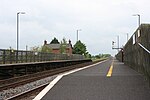Whitton, Lincolnshire
Civil parishes in LincolnshireOpenDomesdayUse British English from December 2013Villages in the Borough of North Lincolnshire

Whitton is a village and civil parish in North Lincolnshire, England. The 2011 census found 212 inhabitants, in 92 households. It is situated at the northern termination of the Lincoln Cliff range of hills, on the south shore of the Humber about 3 miles (4.8 km) below Trent Falls, and 9 miles (14 km) west of Barton-upon-Humber. The parish is bounded on the west by Alkborough, on the east by Winteringham (which also includes the Winteringham Haven Wildlife Reserve) and, to the south, by West Halton.
Excerpt from the Wikipedia article Whitton, Lincolnshire (License: CC BY-SA 3.0, Authors, Images).Whitton, Lincolnshire
Post Office Lane,
Geographical coordinates (GPS) Address Nearby Places Show on map
Geographical coordinates (GPS)
| Latitude | Longitude |
|---|---|
| N 53.708 ° | E -0.634 ° |
Address
Post Office Lane
DN15 9LF , Whitton
England, United Kingdom
Open on Google Maps









